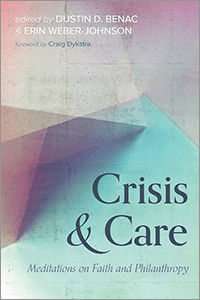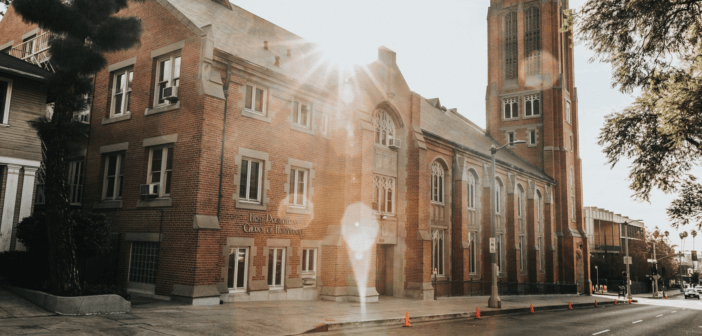How can your church building be an asset rather than a liability? Dave Harder says we must interrogate the dominant narrative that says church is what happens in the building for a few hours on a Sunday and let a new narrative emerge — one that focuses on God’s hopes and dreams for the neighborhood.
Many churches have inherited valuable real estate from previous generations. Our facilities have served admirably, hosting wedding and funerals, baptism, worship services, and music concerts. They have also served the community through Scouts, AA, day care, fundraising dinners, and so much more. Unfortunately, these buildings often become millstones around the neck of congregations as energy is diverted from mission into roof repairs, work parties for painting, with declining, precious funds sent off for ever-increasing utility bills. As churches struggle with these new realities, accelerated in many cases by COVID-19, they invariably turn to the possibility of sale. In my context alone, we are expected to lose 30% of our church buildings over the next five years.
Stuck in an old story
While hundreds of churches have explored opportunities to leverage their land for broader social purposes, very few have been successful. There is an overall excitement about the possibility of change, but then reality quickly sets in or should I say fear takes over. Change is hard. Members have lived into a narrative of church being a certain way for so long while neglecting to consider what new or next could look like.
As someone who works primarily with mainline congregations, I hear a familiar story. It revolves around declining and aging attendance, long-overdue maintenance, lack of missional imagination, and stretched budgets. Churches get stuck in a story, in a narrative of the ways things are, and measuring their success according to that narrative. In working with congregations, the same series of questions emerge: How do we get more young people? How do we grow Sundays? How do we increase committee involvement? How do we add to the choir? How do we increase our budget? All these questions are part of a dominant script that we have come to believe about what it is to be the church, the script that says church is what happens in the building for a few hours on a Sunday and that our success is dependent on that one event.
Allow a new narrative to emerge.
We must interrogate that narrative and let a new one emerge, one that places less emphasis on the success of a Sunday and more on the hopes and dreams of God for the neighborhood. For many congregations, this work can start with them bridging the dreams of God for the neighborhood with their buildings, moving the conversation from Sunday to everyday and church buildings from liability to asset.
Stories have power to form imagination. It is hard to picture something new existing outside of the stories we hear of what others have done. Stories spark imagination and possibility. They also ground and root us in a localized story of place and people. When transformative stories are told, they attend to place, linking people together across place. What if we had stories that reflected a new imagination for our building and leveraged the asset of real estate for sustainable mission the neighborhood? I believe this is a way forward that links our buildings and assets to the stories of the people and the dreams of God in our neighborhoods.
Ask new questions.
So where do we begin? When it comes to our buildings and the burden they carry, how do we move from fear and loss to abundance and innovation? Here lies the inherent problem: the real crisis we face is a lack of imagination. The first step in getting to that place where we can imagine again is interrogating the dominant culture narratives of success, our relationship to money, fear and scarcity, individualism, and polarization.
When infused with a vision for missional presence, churches can become places of belonging that provide a natural fit for a range of social-purpose partnerships, i.e., community hubs, affordable housing, and the arts. To shift our imagination and challenge our beliefs about church space we will need to ask questions like: What is the history of our building? Who has been left out or not included? Who is our property and building for? What are the cracks and crevices in our community? What are the dreams of our neighbors? How could our building be an intersection of community and connection in our neighborhood?
Our questions matter and so does our context and place. We must move beyond a prescriptive model and begin to look and listen to the people around us, listening to our neighborhoods and communities. It’s nearly impossible to love our neighbors if we don’t know our neighbors. And herein lies the tension of our times: we live in such a connected world with such limited connections. Could we imagine that the answers that will propel us into a vibrant and flourishing future are not going to be found inside a church building but on the sidewalks, in coffee shops, and on front porches in our neighborhoods? Could we be brave enough to move beyond the security of our old narratives and begin listening to the stories that are bubbling up from our place?
Now is the time to rethink and reimagine.
COVID-19 appears to have both expedited the urgency (budget holes, fewer rentals, fewer collections) and given a further excuse for inaction and navel-gazing (can’t really do anything now ….). Sadly, in moments of crisis, waiting just acknowledges the path of death we are on, a hospice care of sorts, a sense of holding on peacefully until we pass. We have been given in this moment a chance to rethink and reimagine.
Take a moment to pause and envision our buildings as places where we find joy, beauty, connection, cooperation, and space, where we weave a fabric of love and care in the world, starting with our neighborhood. The path for that new story to emerge is taking action . What would it look like to interrogate the narrative while being curious enough to listen? How can congregations begin asking, “Now what?” In exploring and experimenting, there is opportunity for creating new stories of hope and inspiration in a shifting world. Through holy imagination, listening can turn our buildings from liabilities to assets.
 Adapted from “Reimagining Church Buildings: From Liability to Asset” by Dave Harder in Crisis & Care: Meditations of Faith and Philanthropy, (Cascade Books, 2021) Dustin D. Benac and Erin Weber-Johnson, editors. Used with permission from Wipf and Stock Publishers: www.wipfandstock.com. The book is also available at Cokesbury and Amazon.
Adapted from “Reimagining Church Buildings: From Liability to Asset” by Dave Harder in Crisis & Care: Meditations of Faith and Philanthropy, (Cascade Books, 2021) Dustin D. Benac and Erin Weber-Johnson, editors. Used with permission from Wipf and Stock Publishers: www.wipfandstock.com. The book is also available at Cokesbury and Amazon.
Related Resources
- Flipping the Script of Church Owned Property by Tom Sine and Dwight J. Friesen
- Leveraging Church Property Can Sustain Your Mission by Lovett H. Weems Jr. and Ann A. Michel
- “Leveraging Your Church’s Assets,” a Leading Ideas Talks podcast episode featuring Jacqueline Jones-Smith






